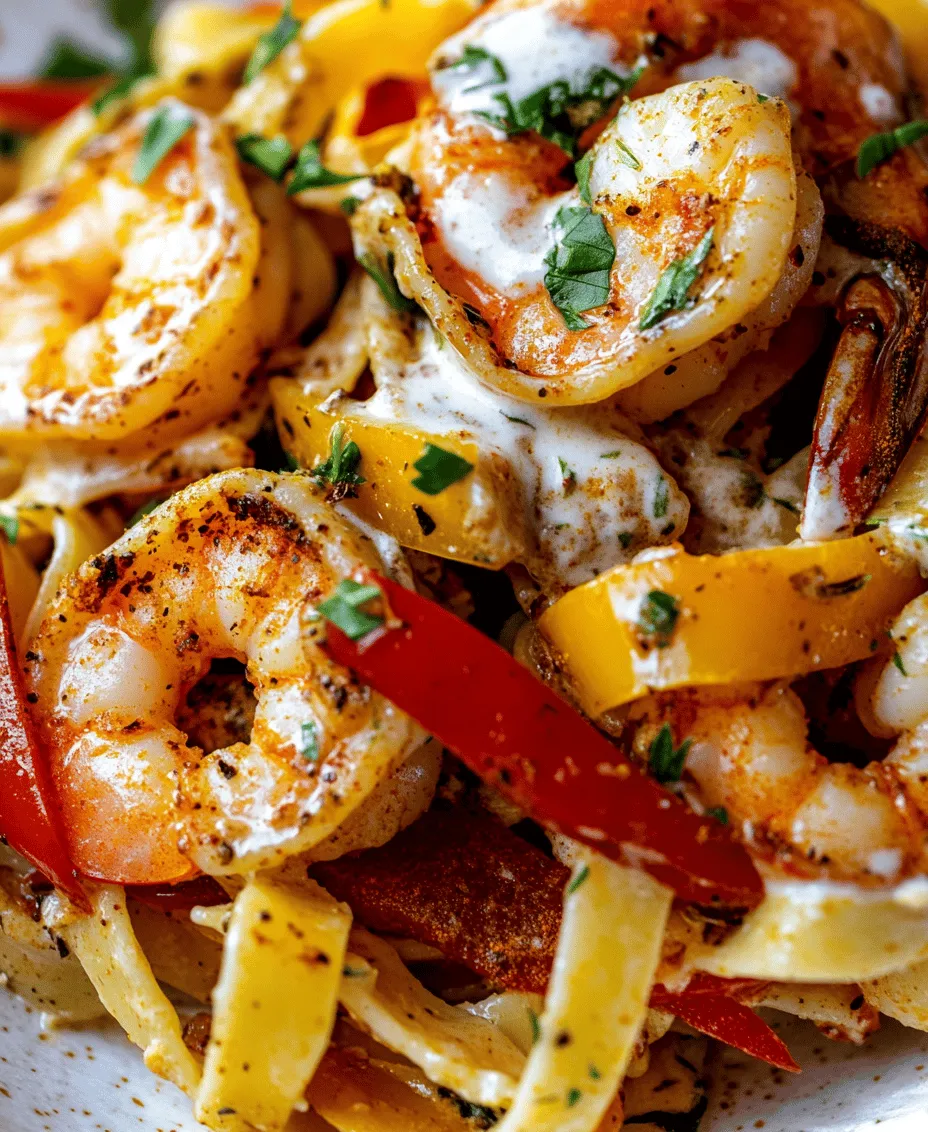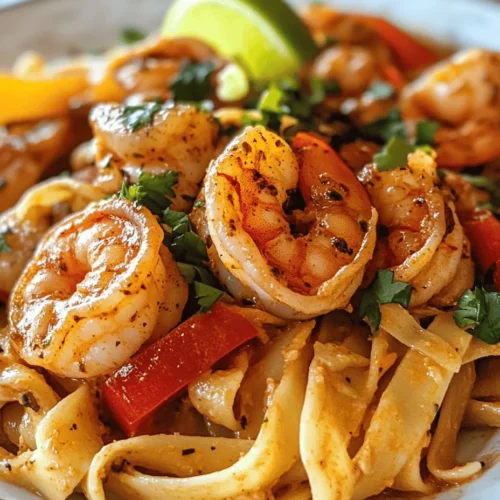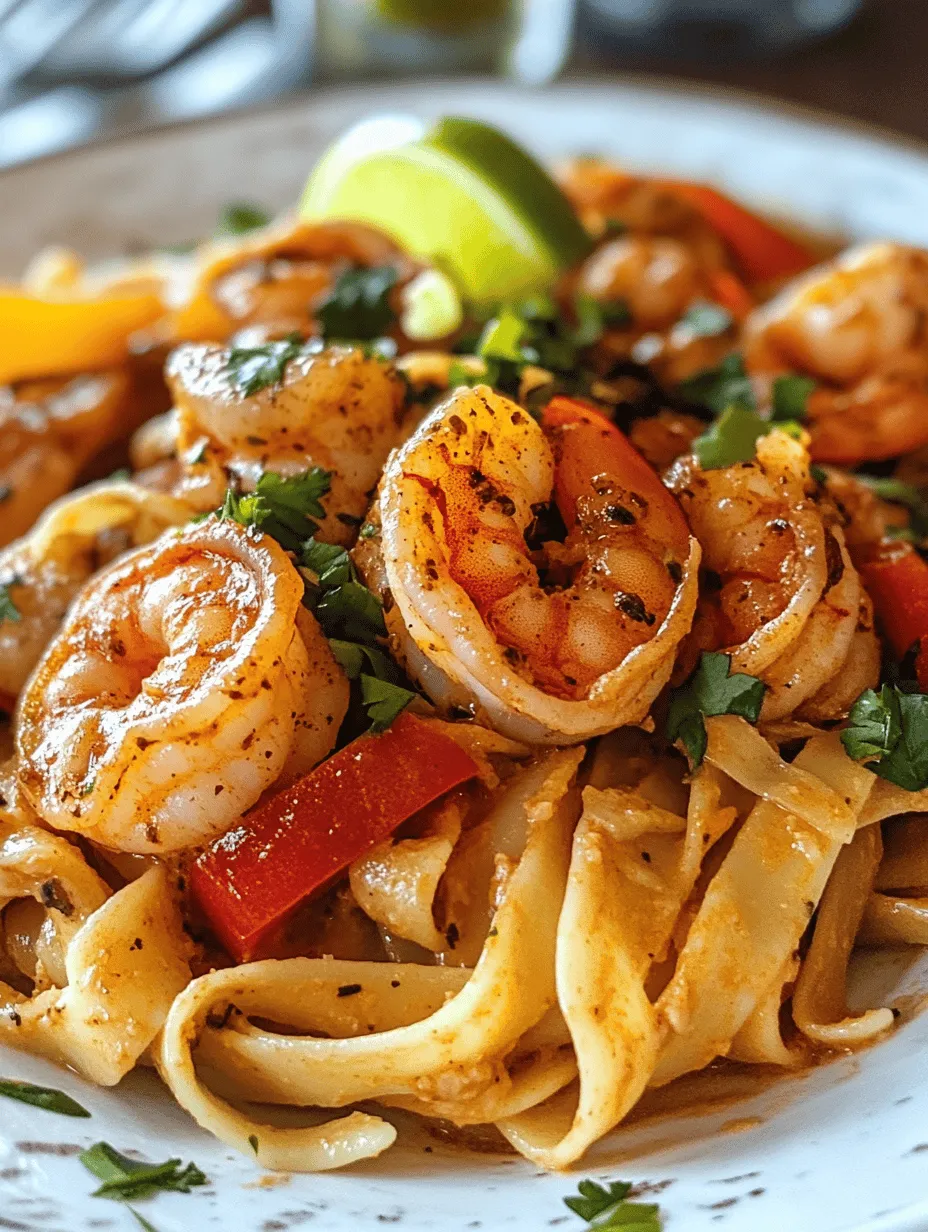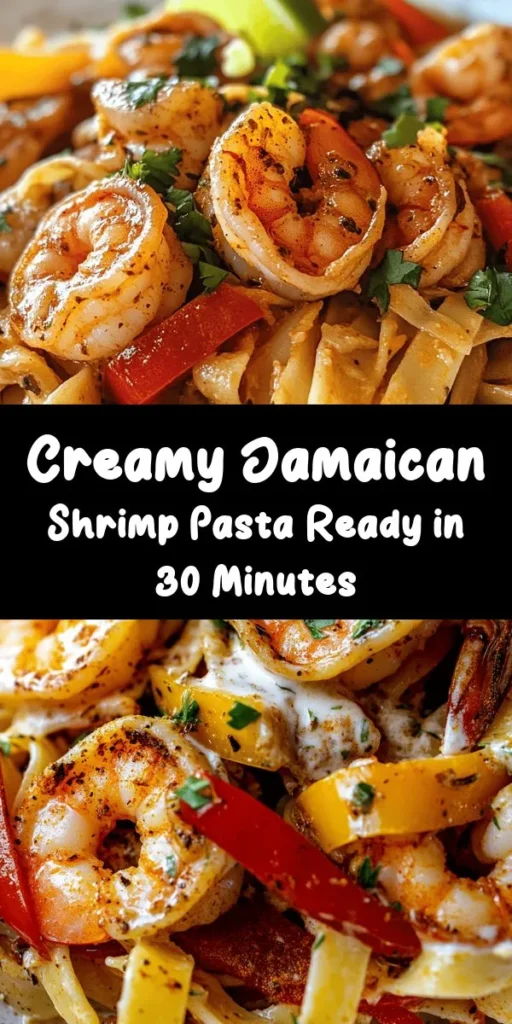Introduction
Jamaican cuisine is a vibrant tapestry woven from the island’s rich history, diverse cultural influences, and an abundance of fresh ingredients. Renowned for its bold flavors, Jamaican food often features spices that awaken the palate and transport diners to sun-kissed shores. Among the many culinary treasures that Jamaica offers, one dish stands out for its captivating fusion of tropical and Italian elements: Jamaican Shrimp Pasta. This delightful recipe is a testament to how different culinary traditions can harmonize, creating something entirely new and delicious.
In this article, we will explore the intricacies of Jamaican Shrimp Pasta, a dish that promises a creamy and flavorful experience for your taste buds. With succulent shrimp nestled atop a bed of fettuccine, enveloped in a luscious sauce that balances the richness of cream with the zesty kick of jerk seasoning, this dish exemplifies the beauty of combining diverse culinary influences in home cooking. Whether you are hosting a dinner party or simply looking to impress your family with a unique meal, Jamaican Shrimp Pasta will surely become a favorite.
The Allure of Jamaican Shrimp Pasta
The appeal of Jamaican Shrimp Pasta lies not only in its sumptuous flavor profile but also in its visual appeal and exotic origins. Picture a vibrant plate of fettuccine, generously coated in a creamy sauce, with tender shrimp glistening atop and a pop of color from bell peppers and fresh herbs. This dish is not just a meal; it is an experience that evokes memories of warm Caribbean breezes and joyful gatherings.
At the heart of this dish is the marriage of shrimp and a variety of spices that characterize Jamaican cuisine. The use of jerk seasoning—a blend of spices including allspice, thyme, and Scotch bonnet peppers—adds a distinctive warmth and complexity to the dish. This seasoning is a staple in Jamaican cooking and carries cultural significance, often representing the island’s history of spice trading and culinary innovation. The combination of spices with the creaminess of coconut milk and heavy cream creates a sauce that is rich in flavor while still allowing the natural sweetness of the shrimp to shine.
Ingredient Breakdown
To create this exquisite Jamaican Shrimp Pasta, it’s essential to gather high-quality ingredients that will enhance the dish’s overall taste. Here’s an overview of the key components:
Fettuccine Pasta
Fettuccine is the pasta of choice for this recipe, and for good reason. The flat, ribbon-like shape of fettuccine allows it to hold onto the creamy sauce beautifully, ensuring that each bite is both flavorful and satisfying. While this recipe calls for fettuccine, you can substitute it with other pasta types like linguine or spaghetti if you prefer. Just be mindful of the cooking times as they may vary.
Shrimp
The star of the dish, shrimp, brings a delicate sweetness and a satisfying texture. When sourcing shrimp, opt for fresh, wild-caught varieties whenever possible, as they tend to have superior flavor and a firmer texture. If fresh shrimp is not available, frozen shrimp can be a convenient alternative. Just make sure to thaw them properly before cooking to ensure even cooking and to prevent a rubbery texture.
Olive Oil
Using high-quality olive oil in your cooking not only enhances the flavor but also contributes healthy fats to the dish. Olive oil is essential for sautéing the shrimp and vegetables, providing a luscious base for the sauce. Look for extra virgin olive oil for its robust flavor and nutritional benefits.
Garlic and Onion
Garlic and onion form the aromatic backbone of many dishes, including our Jamaican Shrimp Pasta. Sautéing these ingredients releases their natural sweetness and creates a fragrant foundation for the sauce. Be sure to use fresh garlic and onion for the best flavor.
Bell Pepper
Adding bell pepper to the mix introduces a pop of color and sweetness, complementing the spiciness of the jerk seasoning. Choose a mix of colors—red, yellow, or green—to create a visually appealing dish that is as pleasing to the eye as it is to the palate.
Coconut Milk
One of the unique ingredients in this recipe is coconut milk, which adds a creamy texture and a hint of tropical flavor. Its natural sweetness balances out the spices, creating a harmonious sauce that envelops the pasta beautifully. When selecting coconut milk, opt for full-fat varieties for a richer taste and creamier texture.
Heavy Cream
To elevate the richness of the sauce, heavy cream is added. This ingredient gives the sauce its luxurious texture, making each bite indulgent. If you prefer a lighter option, you can substitute half-and-half; however, keep in mind that the sauce may not be as creamy.
Jerk Seasoning
The iconic jerk seasoning is what truly sets this dish apart. The spice blend can vary widely in heat and flavor, so consider your spice tolerance when selecting a jerk seasoning. For those who love a kick, a hotter blend will enhance the dish, while milder versions will provide a more subtle warmth.
Lime Juice
To brighten up the dish, a splash of lime juice is essential. The acidity cuts through the richness of the cream and balances the flavors, making the dish more refreshing. Fresh lime juice is always recommended for the best taste.
Fresh Herbs and Parmesan
Finally, a sprinkle of fresh herbs and grated Parmesan cheese adds both color and flavor to the finished dish. Fresh cilantro or parsley can enhance the overall presentation while providing a fresh taste. Parmesan adds a salty, nutty flavor that complements the creaminess of the sauce.
Step-by-Step Cooking Instructions
Now that we’ve gathered all the necessary ingredients, it’s time to dive into the cooking process. Below are detailed instructions to guide you through preparing your Jamaican Shrimp Pasta.
Cooking the Pasta
1. Boil Water: Fill a large pot with water and add a generous amount of salt (about 1-2 tablespoons). The water should taste like the sea, as this is crucial for seasoning the pasta. Bring the water to a rolling boil.
2. Add Fettuccine: Once the water is boiling, add the fettuccine pasta. Stir gently to prevent the noodles from sticking together. Cook the pasta according to the package instructions until al dente, usually around 8-10 minutes.
3. Reserve Pasta Water: Before draining the pasta, reserve about a cup of the starchy cooking water. This liquid can be used later to adjust the sauce’s consistency if needed.
4. Drain and Set Aside: Drain the cooked fettuccine in a colander, and set it aside while you prepare the sauce.
Preparing the Sauce
With the pasta cooking, it’s time to focus on creating the creamy sauce that will bring this dish to life.
1. Sauté Aromatics: In a large skillet, heat 2 tablespoons of olive oil over medium heat. Once hot, add finely chopped onion and minced garlic. Sauté for about 2-3 minutes until the onions are translucent and the garlic is fragrant.
2. Cook the Vegetables: Add sliced bell peppers to the skillet and cook for another 3-4 minutes, stirring frequently until they begin to soften.
3. Add Shrimp: Next, add the shrimp to the skillet. Cook for about 3-4 minutes until they turn pink and opaque. Take care not to overcook the shrimp, as they can become tough if left on the heat for too long.
4. Incorporate Coconut Milk and Cream: Once the shrimp are cooked, pour in the coconut milk and heavy cream, stirring to combine. Let the mixture simmer for a few minutes, allowing the flavors to meld.
5. Season the Sauce: Sprinkle in the jerk seasoning and lime juice, adjusting the amounts to suit your taste preferences. Allow the sauce to simmer for an additional 2-3 minutes, thickening slightly. If the sauce seems too thick, add some reserved pasta water until you reach your desired consistency.
6. Combine Pasta and Sauce: Finally, add the drained fettuccine to the skillet, tossing to coat the pasta in the creamy sauce evenly.
Through these steps, you’ll not only create a delicious dish but also enjoy the intoxicating aromas wafting through your kitchen. The combination of fresh ingredients and vibrant spices will undoubtedly make your Jamaican Shrimp Pasta a standout meal.
Stay tuned for the next part, where we will delve into tips for achieving the best results, address common questions, and explore ways to elevate your Jamaican Shrimp Pasta experience.

Sautéing the Aromatics (Garlic and Onion)
The foundation of any great pasta dish lies in the aromatics, and in our Jamaican Shrimp Pasta, garlic and onion play a crucial role in building flavor. Begin by placing a large skillet over medium heat and adding a tablespoon of olive oil. Allow the oil to heat for a moment before adding in the finely chopped onion. Sauté the onion for about 3-4 minutes, stirring occasionally, until it becomes translucent and fragrant.
Next, add in minced garlic (about 3-4 cloves) and continue to sauté for an additional 1-2 minutes. Be careful not to let the garlic burn, as it can turn bitter if overcooked. The combination of garlic and onion will create a delicious base, contributing to the overall richness of the dish.
Tips for Achieving the Perfect Sauté
1. Heat Control: Keep the heat at medium to avoid burning the ingredients. If you notice any browning, reduce the heat slightly.
2. Pre-chop Ingredients: Have all your ingredients chopped and ready before you start sautéing. This will ensure that you can add everything in a timely manner without the risk of burning.
3. Use Fresh Ingredients: Fresh garlic and onion provide the best flavor. Avoid using pre-minced garlic in a jar, as it lacks the punch of fresh garlic.
4. Add a Pinch of Salt: Sprinkling a little salt while sautéing can help to release the moisture from the onions, allowing them to become sweeter and softer more quickly.
Adding Bell Peppers and Their Role in the Dish
Once the garlic and onion are perfectly sautéed, it’s time to add the bell peppers. Chop one red and one yellow bell pepper into bite-sized pieces and toss them into the skillet. The bell peppers add a vibrant color to the dish and a slight sweetness that complements the savory notes of the shrimp and spices. Sauté the bell peppers with the aromatics for another 4-5 minutes until they become tender yet still retain some crunch.
The bell peppers also provide an additional layer of texture and flavor, making the dish more appealing both visually and palatably.
Cooking the Shrimp: Timing and Techniques for Perfect Doneness
Now, it’s time to introduce the star of the dish: the shrimp. Use about 1 pound of medium or large shrimp, peeled and deveined. Add the shrimp to the skillet, and season them with salt, pepper, and a pinch of cayenne for an extra kick. The shrimp will only need about 2-3 minutes per side to cook through, turning from a grayish color to a beautiful pink.
To avoid overcooking, keep a close eye on the shrimp. As soon as they curl into a C-shape and turn completely pink, they are done. Overcooked shrimp can become rubbery, so remove them from the skillet as soon as they are opaque.
Crafting the Creamy Sauce: Combining Coconut Milk and Heavy Cream
With the shrimp perfectly cooked, it’s time to create the creamy sauce that ties all the flavors together. Lower the heat to medium-low and pour in 1 cup of coconut milk and 1/2 cup of heavy cream into the skillet. Stir gently to combine all the ingredients, allowing the sauce to meld together.
The coconut milk provides a subtle sweetness and tropical flair, while the heavy cream ensures a rich and velvety texture. Simmer the sauce for 2-3 minutes, allowing it to thicken slightly. If you desire more depth of flavor, consider adding a tablespoon of lime juice or a dash of soy sauce to the mixture.
Adjusting Consistency with Reserved Pasta Water
Before you drain the pasta, reserve about 1 cup of the pasta cooking water. This starchy liquid is a valuable asset in adjusting the sauce’s consistency. If the sauce appears too thick, gradually add in the reserved pasta water, stirring continuously until you reach your desired consistency. This step is crucial for ensuring that the sauce clings beautifully to the pasta without becoming too soupy.
Final Steps of Combining Pasta and Sauce for a Cohesive Dish
Once the sauce has reached the perfect consistency, it’s time to combine everything. Add the cooked pasta (about 12 ounces of your choice, such as fettuccine or linguine) directly into the skillet. Toss everything together gently, ensuring the pasta is well-coated in the creamy sauce and that the shrimp and bell peppers are evenly distributed. Let the pasta sit in the sauce for a minute or two on low heat, allowing the flavors to meld.
Nutritional Value and Benefits
Jamaican Shrimp Pasta is not only a culinary delight but also packs a nutritional punch.
1. Protein from Shrimp: Shrimp is a high-protein food, offering around 20 grams of protein per 3 ounces. It’s also low in calories and saturated fat, making it an excellent choice for a healthy meal.
2. Healthy Fats from Olive Oil and Coconut Milk: The olive oil used for sautéing is rich in monounsaturated fats, which are heart-healthy. Coconut milk, while higher in fat, provides medium-chain triglycerides (MCTs) that can be beneficial for energy and metabolism.
3. Carbohydrates from Pasta: The pasta provides a source of carbohydrates, which are essential for energy. Opting for whole grain or legume-based pasta can enhance the fiber content of the dish.
4. Dietary Considerations: For those with gluten sensitivities, gluten-free pasta options made from rice, quinoa, or chickpeas can be easily substituted, making this dish accessible to a wider audience.
Serving Suggestions
Presentation is key when serving Jamaican Shrimp Pasta. Here are some ideas to enhance your plating:
– Plating Ideas: Serve the pasta in a large bowl or on individual plates. Garnish with freshly chopped parsley or cilantro for a pop of color. A sprinkle of red pepper flakes can add visual interest and a hint of spice.
– Ideal Pairings: This dish pairs beautifully with a crisp green salad dressed with lime vinaigrette to balance the richness of the pasta. For beverages, consider serving a chilled white wine, like Sauvignon Blanc, or a refreshing tropical mocktail.
– Variations for Dietary Preferences: For a vegetarian option, substitute the shrimp with grilled vegetables or chickpeas. You can also create a vegan version by using plant-based heavy cream in place of dairy and opting for vegetable broth for extra flavor.
Culinary Tips and Techniques
1. Importance of Seasoning Throughout the Cooking Process: Seasoning at multiple stages of cooking—during the sautéing of aromatics, while cooking shrimp, and in the sauce—ensures that every component of the dish is flavorful.
2. Techniques for Sautéing Shrimp to Avoid Overcooking: Always ensure your shrimp are spread out in the pan without overcrowding. This allows for even cooking and helps maintain the shrimp’s juiciness.
3. Tips for Making the Dish Ahead of Time and Reheating: If you plan to prepare the dish in advance, cook the pasta and sauce separately. Combine them just before serving to prevent the pasta from soaking up too much sauce. When reheating, add a splash of reserved pasta water to the skillet to restore creaminess.
Conclusion
Jamaican Shrimp Pasta is an exquisite fusion of flavors that brings together the vibrant tastes of the Caribbean with the comforting essence of Italian cuisine. The creamy sauce, perfectly sautéed shrimp, and fresh vegetables create a dish that is not only satisfying but also easy to prepare.
This recipe celebrates the joy of cooking and the pleasure of sharing a delicious meal with family and friends. Embrace the unique flavors of this dish, and allow it to transport you to the sunny shores of Jamaica, even if you’re cooking from the comfort of your home. Explore the culinary world with this delightful recipe, and enjoy the process of creating something truly special in your kitchen.



